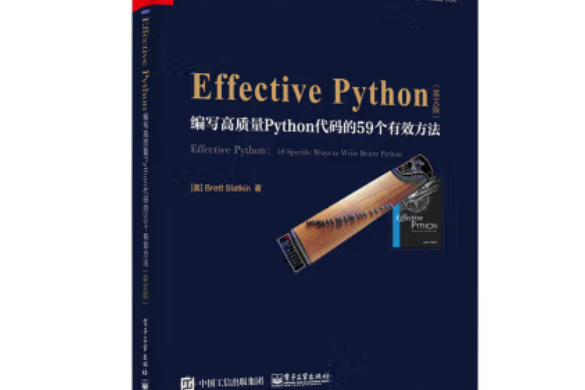《Effective Python:編寫高質量Python代碼的59個有效方法英文版》是2016年電子工業出版社出版的圖書,作者是[美] Brett Slatkin(布雷特·斯拉特金)。
基本介紹
- 中文名:Effective Python:編寫高質量Python代碼的59個有效方法英文版
- 作者:[美] Brett Slatkin(布雷特·斯拉特金)
- 出版社:電子工業出版社
- 出版時間:2016年3月1日
- 頁數:248 頁
- 定價:65 元
- 開本:16 開
- 裝幀:平裝
- ISBN:9787121272622
內容簡介,圖書目錄,作者簡介,
內容簡介
《Effective Python:編寫高質量Python代碼的59個有效方法 英文版》不是要講述Python的基礎編程,而是要幫你掌握Python獨特的優勢和魅力。《Effective Python:編寫高質量Python代碼的59個有效方法 英文版》中總結了59個Python編程的優秀實踐、貼士和捷徑,並用真實代碼示例進行了解釋。《Effective Python:編寫高質量Python代碼的59個有效方法 英文版》共分8章,第1章講述Python的風格思想,介紹了Python中常見問題的推薦解決方案;第2章講述如何使用Python函式來闡明意圖、提升可重用性,並減少錯誤;第3章介紹如何使用類和繼承來表達你對對象的預期行為;第4章介紹了使用這些元類和屬性的常用語法;第5章講述如何在並行和並發的場景下利用好Python;第6章講述Python中必要的內置模組;第7章教你如何合作開發Python程式;第8章介紹如何使用Python調試、最佳化和測試程式。
圖書目錄
前言
致謝
關於作者
Chapter 1: Pythonic Thinking
Item 1: Know Which Version of Python You’re Using
Item 2: Follow the PEP 8 Style Guide
Item 3: Know the Differences Between bytes , str , and unicode
Item 4: Write Helper Functions Instead of Complex Expressions
Item 5: Know How to Slice Sequences
Item 6: Avoid Using start , end , and stride in a Single Slice
Item 7: Use List Comprehensions Instead of map and filter
Item 8: Avoid More Than Two Expressions in List Comprehensions
Item 9: Consider Generator Expressions for Large Comprehensions
Item 10: Prefer enumerate Over range
Item 11: Use zip to Process Iterators in Parallel
Item 12: Avoid else Blocks After for and while Loops
Item 13: Take Advantage of Each Block in try / except / else / finally
Chapter 2: Functions
Item 14: Prefer Exceptions to Returning None
Item 15: Know How Closures Interact with Variable Scope
Item 16: Consider Generators Instead of Returning Lists
Item 17: Be Defensive When Iterating Over Arguments
Item 18: Reduce Visual Noise with Variable Positional Arguments
Item 19: Provide Optional Behavior with Keyword Arguments
Item 20: Use None and Docstrings to Specify Dynamic Default Arguments
Item 21: Enforce Clarity with Keyword-Only Arguments
Chapter 3: Classes and Inheritance
Item 22: Prefer Helper Classes Over Bookkeeping with Dictionaries and Tuples
Item 23: Accept Functions for Simple Interfaces Instead of Classes
Item 24: Use @classmethod Polymorphism to Construct Objects Generically
Item 25: Initialize Parent Classes with super
Item 26: Use Multiple Inheritance Only for Mix-in Utility Classes
Item 27: Prefer Public Attributes Over Private Ones
Item 28: Inherit from collections.abc for Custom Container Types
Chapter 4: Metaclasses and Attributes
Item 29: Use Plain Attributes Instead of Get and Set Methods
Item 30: Consider @property Instead of Refactoring Attributes
Item 31: Use Descriptors for Reusable @property Methods
Item 32: Use __getattr__ , __getattribute__ , and __setattr__ for Lazy Attributes
Item 33: Validate Subclasses with Metaclasses
Item 34: Register Class Existence with Metaclasses
Item 35: Annotate Class Attributes with Metaclasses
Chapter 5: Concurrency and Parallelism
Item 36: Use subprocess to Manage Child Processes
Item 37: Use Threads for Blocking I/O, Avoid for Parallelism
Item 38: Use Lock to Prevent Data Races in Threads
Item 39: Use Queue to Coordinate Work Between Threads
Item 40: Consider Coroutines to Run Many Functions Concurrently
Item 41: Consider concurrent.futures for True Parallelism
Chapter 6: Built-in Modules
Item 42: Define Function Decorators with functools.wraps
Item 43: Consider contextlib and with Statements for Reusable try / finally Behavior
Item 44: Make pickle Reliable with copyreg
Item 45: Use datetime Instead of time for Local Clocks
Item 46: Use Built-in Algorithms and Data Structures
Item 47: Use decimal When Precision Is Paramount
Item 48: Know Where to Find Community-Built Modules
Chapter 7: Collaboration
Item 49: Write Docstrings for Every Function, Class, and Module
Item 50: Use Packages to Organize Modules and Provide Stable APIs
Item 51: Define a Root Exception to Insulate Callers from APIs
Item 52: Know How to Break Circular Dependencies
Item 53: Use Virtual Environments for Isolated and Reproducible Dependencies
Chapter 8: Production
Item 54: Consider Module-Scoped Code to Configure Deployment Environments
Item 55: Use repr Strings for Debugging Output
Item 56: Test Everything with unittest
Item 57: Consider Interactive Debugging with pdb
Item 58: Profile Before Optimizing
Item 59: Use tracemalloc to Understand Memory Usage and Leaks
Index
作者簡介
Brett Slatkin,是一名谷歌高級軟體工程師,他是谷歌消費者調查的工程主管兼聯合創始人之一。他曾供職於Google App Engine的Python基礎設定部門。他是PubSubHubbub協定的創建者之一。十年前,年紀輕輕的他就已經在用Python來管理谷歌龐大的伺服器機群了。
除了日常工作之外,他還研究開源的工具,會在他的個人網站寫軟體、腳踏車等方面的文章。他獲得了哥倫比亞大學(紐約)計算機工程學士學位。目前住在舊金山。

